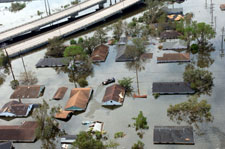
|
| (Photo courtesy of FEMA) |
A top official of the U.S. Army Corps of Engineers says that none of the accusations that it is responsible for poor design and construction of the failed New Orleans flood protection system have been proven yet.
In an interview, the Corps’ director of civil works described how the Corps sees its culpability in the flooding of New Orleans six months after Katrina.
More than blame and the reputation of the Corps is at stake.
Many people in New Orleans say they are wary of rebuilding until the levee and storm protection system that was badly damaged by last fall’s assault by hurricanes Katrina and Rita has been restored to pre-Katrina levels, at least. But many also say they have lost faith in the ability of the Corps to build and maintain a system that will protect the city, and that has stalled reconstruction planning and discouraged residents from returning. Sen. Mary L. Landrieu (D) of Louisiana has said that the Corps failed the American people and at least one engineer investigating the flood claims the Corps did not follow its own specifications in designing and building the flood protection system.

|
| Maj. Gen. Don T. Riley describes the limits of the Corps’ responsibility for the New Orleans disaster. |
In a telephone interview Feb. 14, Maj. Gen. Don T. Riley, said none of the accusations about design and construction flaws have yet been proven and that the flood protection system was created by the Corps under limits and according to what Congress authorized and funded. The Corps could do no more, he said.
Riley was asked what will it take to restore the residents’ confidence in the Corps, or if people are asking too much by expecting engineering to make the city safe.
“It is our commitment to build confidence back in the public and faith in the hurricane protections they will live within,” Riley responded. “We are repairing them to pre-Katrina levels and repairing them in an improved state…We can only go as far as we are authorized, but we are trying to build contingencies into that system so that it will be resilient in a storm it is designed to withstand.”
He added that the administration is preparing to announce changes in the restoration effort “that will help us build even more confidence into the community.” Riley also said the Corps is giving frequent briefings to business and government groups and “providing them all of our charts and figures and how we are progressing in the construction.”
“We are trying to outreach as much as we possibly can through television, radio and local newspapers,” Riley added.
During the repairs currently under way, he said, “We are doing a lot more inspections than normal. We are inspecting the borrow material when it arrives and we are inspecting it again as it is placed.”
However, with respect to the city’s interior outfall canals, two of which were breached, he said, “We are not confident at all in the interior canals. Our interim solution is a temporary closure at the ends of the canals and temporary pumps to pump out rainfall. But we are also talking to administrators of the sewer and water board and levee boards about permanent pumps for the canals at the lake. For now we will just close it off in the event of a storm surge so those canal levees will not come into play,” he said.
As far as guaranteed safety, he pointed out that hurricanes still pack a lot of unknowns, particularly very strong ones. “Katrina could have been a lot less devastating if it had been on a different track…or a lot more devastating,” he said, adding, “There is no high-end to a Cat 5. You can’t protect against everything.”
RAISING ALARMS
Asked it the Corps had failed to do its duty by not pressing publicly and more insistently over the last few decades for a more robust system of storm protections, Riley said, “We are not, by law, allowed to advocate for any project. We are not advocating for projects, we are advocating for our process.”
“We can’t lobby the Congress. That’s against the law. Guys like me go to jail for that, or are asked to retire very quickly,” Riley added.
“Within the administration we have some different rules…we can bring our recommendations to the administration. Then the administration makes a proposal to Congress of whether to fund something or not. Then Congress takes that recommendation and does whatever they choose to do. We can only do, in the end, what Congress authorizes us to do—and appropriates funds for. That is, essentially, our budget—that and any supplemental request the administration might propose. They also may authorize a project but only appropriate a portion of the funds, and that is all we can spend on that project,” Riley says.
“The administration is getting ready to bring a new proposal to Congress to authorize future work,” Riley added, “specifically for New Orleans and the levee system.”
“All of our people who are out there doing great things can be frustrated by not being authorized to do something, but on the Hill, in Congress, they can be frustrated too. There are many competing requirements. They have a tough job...and we can’t advocate for one project over another.”
With respect to the hurricane protections in Louisiana built after Hurricane Betsy in 1965, Riley says Congress initiated the process. It asked for a feasibility study and proposal for construction of a system to protect New Orleans from what was termed at that time, before the advent of the Safir-Simpson scale for describing hurricane severity, as “a design storm.” The design storm was a fast moving hurricane with 115 mile-per-hour winds.
Although Riley says Katrina hit land with winds “a good bit more than that,” the design storm intensity was pretty much what it was throwing at the Lake Pontchartrain face of New Orleans when the floodwalls and levees that line the big drainage canals leading from the heart of the city to the lake began to fail.
The canal levees and floodwalls are a legacy of the planning begun in 1965. After conducting the feasibility study, the Corps proposed a barrier plan that would have blocked off Lake Pontchartrain’s outlets to the Gulf of Mexico as well as the lakeshore mouths of the drainage canals. Riley described it as a process and plan with “sponsors and environmental stakeholders” that ultimately stalled over unanswered environmental questions.
“We did not do a thorough environmental analysis of the barrier plan, and the courts says we couldn’t do [build] it,” he says.
So then there was a move from a barrier plan to a “parallel protection” system.
Riley was asked if the Corps doesn’t have a professional responsibility, as the ranking subject matter expert and overarching authority, to push relentlessly for the most robust, integrated, well managed and well maintained flood protection system its experts can envision. He was also asked if, by failing to press for that in Congress, and by bowing to local pressures and the fragmented levee board system, it had failed to meet its responsibility to take all possible steps to prevent disaster. He replied again that the Corps must operate within the limits of its authorization and funding, but added that it also has a “responsibility to work with local and state partners in a collaboration.”
SPONSORS AND PARTNERS
For example, Riley says, the cost of a feasibility study is split 50/50 with a local sponsor. Construction costs are shared on a federal /local split of either 75%/25% or sometimes 65%/35%, depending on the nature of the project. “So we have a sponsor out there who is paying a substantial sum of money who also gets a say in how that money is spent, whether it be a levee board or a hydro power customer who participates in a water control project,” Riley says. “They all have a say in that,” he said, adding: “They are the ones who can be advocates and press Congress for a particular project. They are allowed to advocate—and we are not.”
Asked, if that meant the Corps would go along with a plan even if it knew it wouldn’t do the job, he said, “If we know it doesn’t do the job we don’t do it.”
Sponsor preferences prevailed in design decisions that were made in the shift from the barrier plan to the parallel protection plan, particularly in the decision not to build storm gates at the mouths of the canals.
“We worked with the sponsors over whether it was going to be a gate at the lake or not. They didn’t want a gate because they wanted to be able to pump during a rainstorm. They all agreed it would be adequate protection in a “design storm,” Riley said. Yet in those conditions, canal levees and floodwalls failed in three places along the canals and almost failed in more. That aspect of the system performance is under particularly intense scrutiny.
Katrina’s surge “did not overtop in those interior canals,” Riley says. “The static loads were below the design level. But we are doing physical modeling to study the dynamic load—the wind load and the churning dynamic effect of splash within those canals.”
INVESTIGATION
When asked to respond to commonly voiced criticisms that design and construction flaws played a significant role in the flooding, and preventing those flaws was the responsibility of the Corps, Riley replied that “we haven’t concluded that [there were design or construction flaws] yet.”
“There have been accusations made early on by some investigators of malfeasance. None of that has born out yet. Early on there were conclusions by others that the piles weren’t driven down far enough into the peat layer. We haven’t...


Post a comment to this article
Report Abusive Comment